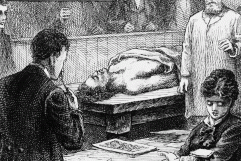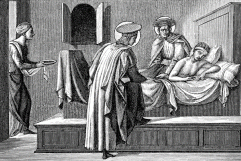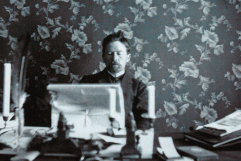
Pandemics, great discoveries and happy coincidences
Medicine has had to face up to many great challenges since Ancient Times, such as the Black Death, which devastated Europe, Africa and Asia in the 14th century, or Spanish flu, which first appeared in the United States.
Pandemics have been cyclic in the history of mankind, from the Black Death or Spanish flu, to the current one caused by Covid-19. The 14th century was the era of the Black Death, when the largest epidemic in European history broke out between 1346 and 1347, and which could have reached 60% of the population.
Its origins would have been in the city that today is called Feodosia, on the south-eastern Crimean coast, on the banks of the Black Sea, which in the 14th century was a Genoan trade enclave called Caffa. The city was considered by the Italians to be “the Queen of the Great Sea” and the Khan of the Golden Horde Jan Beg wanted it. Carlos Aitor Yuste and Jon Arrizabalaga affirm in their book, This wasn’t in my History of Medicine book that the Mongolian troops were laying siege to Caffa when suddenly the plague broke out amongst the soldiers, killing thousands of them. Faced with the impossibility of taking the city, the khan ordered catapults to be assembled and the bodies of the dead soldiers were launched into the city to spread panic.
Los historiadores no se ponen de acuerdo en si fueron los cadáveres los que propagaron la peste o si la bacteria, conocida como Yersinia pestis, penetró a la ciudad a través de las ratas infectadas y las pulgas. El caso es que numerosos comerciantes huyeron de la ciudad rumbo a Italia y llevaron la peste a Génova. Un año después, la enfermedad se había extendido por toda Europa y asolaba Asia y África.
Victims of the plague
It was not the first time that Europe had experienced the chaos of a pandemic. The Athenian general Thucydides tells in his History of the Athenian plague, how 30,000 citizens, including Pericles, died from an infectious disease, caused when the inhabitants of the Peloponnesian islands poisoned the water wells. This plague was in fact an epidemic of Typhoid fever, caused by the bacteria Salmonella tiphy, according to the doctor, writer and scientific proponent Pedro Gargantilla in his book Historia curiosa de la medicina (A curious history of medicine). A plague of what was thought to be smallpox or measles also brought an end to the life of one of the great characters in history: the Roman Emperor Marco Aurelio. It was called the Antonine Plague or Plague of Galen, starting in the year 165 A.D. and it brought an end to the lives of over 5,000 people.
Pericles died in Athens from Typhoid fever, along with 30,000 citizens and the Emperor Marco Aurelio due to a plague of measles or smallpox
Doctors over the centuries have had to face up to other diseases that have affected a large part of the population. This is the case of tuberculosis or the white plague. It is known that it is a very ancient disease because lesions have been found in Egyptian mummies from 3700 B.C. Smallpox has also represented a serious challenge for medicine. In August, 1742, it caused the death of Louis I of Spain, who at the age of 17 years only ruled for 229 days; and long before this, the death of Ramses V, the fourth Pharaoh of the 20th dynasty in Egypt. Until a vaccine was found (the first in history), in the 18th century smallpox killed around 400,000 people per year in Europe. A very long time prior to this, the ancients had observed that whoever survived the disease did not suffer from it again and in the year 1000 A.D., experiments were started with reduced forms of the disease, according to Carlos Aitor Yuste and Jon Arrizabalaga. Samples were taken from the contagious scabs on the patients and they were left to dry for a year to reduce their effect. Then, they were turned into powder and inoculated into healthy patients. This was a real Russian roulette.
The first vaccine
At the end of the 18th century, researchers realised that the dairy maids who milked the cows infected with the bovine variant of smallpox only developed very slight symptoms of the disease and they decided to inoculate it into healthy people. In 1790, the English doctor Edward Jenner went one step further.
The English doctor, Edward Jenner injected his gardener's eight-year-old son with the pus from a smallpox pustule, a vaccine from an infected dairy maid
Jenner injected his gardener’s eight-year-old son with the pus from a smallpox pustule, taken from an infected dairy maid. The child, in spite of being in contact with the virus, did not become ill. The doctor repeated it with another 23 people with the same result and in 1789 the first vaccine in history was born. It was so successful that mass vaccinations were started and even Napoleon Bonaparte ordered his entire army to be vaccinated.
Throughout history there have been other pandemics, such as the Spanish flu, the patient zero of which died in Kansas (USA) on the 11th of March, 1918. It was given this name because during the First World War Spain was a neutral country and gave daily reports on the deaths due to this disease. The countries taking part in the conflict preferred not to do this because they feared that it would demoralise their populations.



